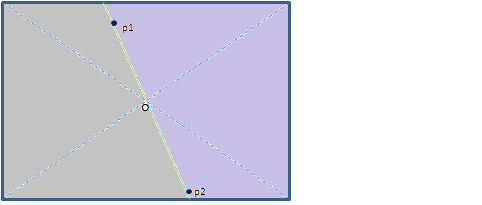Well, after seeing the solution I guess I have a proof for the question.
Like many others earlier, the probability for the first and the second points to lie on the same half is $1$. I would not get into that as it is already shown by other.
Now we know that the 1st and the second points will always lie in the same half. Considering the 3rd point, lets define the worst case as when the probability of the 3rd point to lie in the same half is minimal, and best case when the probability of the 3rd point lying on the same half is maximum.
Worst Case:

In this case the probability of point $p_3$ lying in the same half is almost $0.5$.
Best Case:

In this case the probability of point $p_3$ lying in the same half is almost $1.0$.
Now comes a little complicated part. Consider the "separating line" is changing it's slope continuously by a very small amount. In that case the two halves will keep changing shapes. It's important to notice that in the intervals of $180$ degrees and $360$ degrees the all the halves are taken into consideration and since the halves can be defined by any "separating line", we can safely say that the probability of the point $p_3$ will increase uniformly from worst case to best case. That is, uniformly from $0.5$ to $1.0$.
Thus, the overall probability of point $p3$ lying in the same half will be
$(1.0 + 0.5) \div 2 = \frac{3}{4}$
Similarly, for the point $p_4$, it's not difficult to see that the worst case and best case probability to lie in the same half would be the same as point $p_3$, that is, $0.5$ and $1.0$ respectively. And, the overall probability would be the same as well, i.e. $\frac{3}{4}$.
Now, the easy part. The overall probability of the $4$ points lying in the same half would be: $\frac{3}{4} \times \frac{3}{4} = \frac{9}{16}$
Thus, proved.
Thanks for the check mark in advance :P.
Please correct me if you think I am wrong.




